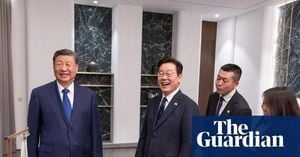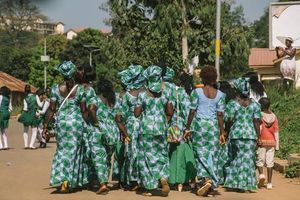As dusk settles over the small town of Kivshovata, just outside Kyiv, the air fills with a familiar, unsettling buzz. For 14-year-old Rostyslav Musiienko, this is not just any night. It’s another evening marked by the haunting sound of Iranian-designed Shahed drones sweeping overhead, a now-constant reminder of the war that has changed every aspect of life in Ukraine. According to NPR, Rostyslav hears this buzzing almost nightly, and the fear it brings is visceral. “When it picks up speed, I hide because I’m scared,” he confides. Yet, Rostyslav has found a way to channel that fear into something remarkable: music.
Inside a brightly lit rehearsal hall, the Harmonia youth orchestra gathers. Most of these musicians are middle schoolers, their lives upended by conflict, yet their resolve unbroken. Together, they are composing a piece that captures the very essence of their wartime experience. They call it the "Shahed Overture." The orchestra’s project, as reported by NPR’s Joanna Kakissis, is not just a musical endeavor—it’s a living chronicle of Ukraine’s nights under siege.
The orchestra is led by conductor Serhii Neduzhyi, whose passion is matched only by his deep sense of responsibility. On stage, he straps on a bass drum and hums a gentle tune to his 14-year-old daughter, Anna, the lead violinist. Anna begins the overture with a melody that evokes a peaceful, ordinary night. “It’s pleasant and peaceful,” she says, her words carrying the weight of longing. “An ordinary day in an ordinary city until a terrible reality intrudes.”
That intrusion comes swiftly in the music, just as it does in life. The overture’s calm is shattered by the sounds of air raid sirens, then the unmistakable drone buzz—recreated by Rostyslav on his trombone. Conductor Neduzhyi’s bass drum mimics explosions, while strings and brass capture the chaos of antiaircraft fire. The orchestra’s composition doesn’t shy away from the grim details: the drone is shot down, its wreckage tumbling onto the city, followed by the wail of ambulance and firefighter sirens. The music then shifts, echoing the frantic efforts of rescue workers digging through rubble, and the piercing cry of a baby—a sound that, as Neduzhyi explains, is all too real for these young musicians.
“The drumming,” Neduzhyi says, “is a heartbeat.” At first, it’s almost imperceptible—a faint echo of life amidst destruction. But as the overture builds, so does the heartbeat, growing stronger and louder, a symbol of resilience and hope. It’s a powerful metaphor, one that resonates deeply with every member of Harmonia.
For these young musicians, the horrors of war are not abstract. Russian strikes have blown out the windows of their homes and forced them into bunkers at school. Nearly every week, they are called upon to perform at the funerals of local soldiers—an experience that leaves scars far deeper than any shrapnel. Ruslana Halaziuk, a 20-year-old drummer in the orchestra, struggles to put her feelings into words. “You just stand there,” she says, “and you just cannot hold back your tears.” Her voice, translated from Ukrainian by NPR, carries the sorrow of a generation forced to grow up too soon.
The transition from playing jazz and funk to composing the "Shahed Overture" was not one the orchestra made lightly. Guitar teacher Dmytro Korniienko recalls, “We used to play jazz and funk songs. This composition reflects the horror that we now live in.” Their music is no longer just an artistic outlet; it’s a form of collective therapy, a way to process trauma and assert their humanity in the face of relentless violence.
What makes the "Shahed Overture" so extraordinary is its authenticity. Every sound, every note, is rooted in lived experience. The musicians don’t just interpret the sounds of war—they embody them. The piece is still unfinished, mirroring the ongoing conflict that shapes their lives. As of October 24, 2025, the war continues, and so does the overture. The musicians linger on a hopeful note, refusing to let despair have the final word.
The Harmonia orchestra’s project has drawn attention far beyond the borders of Ukraine. According to NPR, their symphonic poem is a vivid re-creation of wartime nights, a testament to the power of art in the darkest of times. It’s also a reminder of the resilience of Ukraine’s youth—a generation that, despite everything, refuses to be silenced.
But why music? For many in Harmonia, it’s the only language powerful enough to capture what words cannot. The overture is not just a chronicle of suffering; it’s a declaration of survival. The heartbeat at its core is not just a musical motif—it’s a promise that, even in the shadow of war, life endures.
Music has long played a role in times of conflict, from Shostakovich’s Leningrad Symphony during World War II to the protest songs of the Vietnam era. Yet the "Shahed Overture" is uniquely Ukrainian, shaped by the specific sounds and rhythms of a war that is still unfolding. It’s a living document, one that will continue to evolve as long as the conflict persists.
The orchestra’s efforts have inspired others in their community. Parents, teachers, and neighbors attend rehearsals, sometimes offering their own stories and memories to be woven into the music. For many, the overture provides a rare moment of catharsis—a chance to grieve, to remember, and, just maybe, to hope.
As the final notes of a rehearsal fade, the young musicians pack up their instruments, ready to face another uncertain night. The war has taken much from them, but it has not taken their spirit. Through their music, they assert their right to dream, to create, and to endure. The "Shahed Overture" remains unfinished, a work in progress—just like the lives of those who play it. But in every heartbeat, every note, there is the promise of a future worth fighting for.




